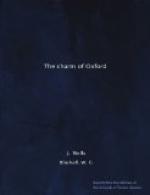“Morn of the year, of
day and May the prime,
How fitly do we scale
the steep dark stair,
Into the brightness
of the matin air,
To praise with chanted
hymn and echoing chime,
Dear Lord of Light,
thy sublime,
That stooped erewhile
our life’s frail weeds to wear!
Sun, cloud and hill,
all things thou fam’st so fair,
With us are glad and
gay, greeting the time.
The College of the Lily
leaves her sleep,
The grey tower rocks
and trembles into sound,
Dawn-smitten Memnon
of a happier hour;
Through faint-hued fields
the silver waters creep:
Day grows, birds pipe,
and robed anew and crowned,
Green Spring trips forth
to set the world aflower.”
The tower was put to a far different use when, in the Civil War, it was the fortress against an attack from the east, and stones were piled on its top to overwhelm any invader who might force the bridge.
Tradition connects this tower with the name of Magdalen’s greatest son, Thomas Wolsey, who took his B.A. about 1486, at the age of fifteen, as he himself in his old age proudly told his servant and biographer, Cavendish. Certainty he was first Junior and then Senior Bursar for a time, while the tower was building, 1492-1504. But the scandal that he had to resign his bursarship for misappropriation of funds in connection with the tower may certainly be rejected.
On the right of Magdalen Bridge, looking at the tower, as we see it in the picture, stretches Magdalen Meadow, round which run the famous water walks. The part of these on the north-west side is especially connected with Joseph Addison, who was a fellow at Magdalen from 1697 to 1711. He was elected “demy” (at Magdalen, scholars bear this name) the first year (1689) after the Revolution, when the fellows of Magdalen had been restored to their rights, so outrageously invaded by King James. This “golden” election was famous in Magdalen annals, at once for the number elected—seventeen—and for the fame of some of those elected. Besides the greatest of English essayists, there were among the new “demies,” a future archbishop, a future bishop, and the high Tory, Henry Sacheverell, whose fiery but unbalanced eloquence overthrew the great Whig Ministry, which had been the patron of his college contemporary.
Magdalen Meadow preserves still the well-beloved Oxford fritillaries, which are in danger of being extirpated in the fields below Iffley by the crowds who gather them to sell in the Oxford market.
Of the part of the College on the High Street, the most interesting portion is the old stone pulpit (shown in Plate XIV). The connection of this with the old Hospital of St. John is still marked by the custom of having the University sermon here on St. John the Baptist’s Day; this was the invariable rule till the eighteenth century, and the pulpit (Hearne says) was “all beset with boughs, by way of




